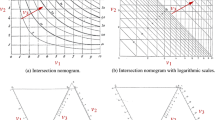Abstract
Transforming any tool into a mathematical instrument for students involves a complex ‘instrumentation’ process and does not necessarily lead to better mathematical understanding. Analysis of the constraints and potential of the artefact are necessary in order to point out the mathematical knowledge involved in using a calculator. Results of this analysis have an influence on the design of problem situations. Observations of students using graphic and symbolic calculators were analysed and categorised into profiles, illustrating that transforming the calculator into an efficient mathematical instrument varies from student to student, a factor which has to be included in the teaching process.
Similar content being viewed by others
REFERENCES
Artigue, M. (1995). Une approche didactique de l'intégration des EIAO. In D. Guin, J.-F. Nicaud and D. Py (Eds), Environnements Interactifs d'Apprentissage avec Ordinateur (pp. 17-29). Paris: Eyrolles.
Artigue, M. (1997). Computer environments and learning theories in mathematics education. In B. Barzel (Ed.), Teaching Mathematics with Derive and the TI-92, Proceedings of the International Derive and TI-92 Conference (pp. 1-17). Bonn.
Artigue, M., Defouad, B., Dupérier, M., Juge, G. and Lagrange, J. B. (1997). L'intégration de calculatrices complexes à l'enseignement scientifique au lycée. Research Report, Cahier de Didirem (3), Université Paris VII.
Artigue, M. (1998). Teacher training as a key issue for the integration of computer technologies. In D. Tinsley and D. C. Johnson (Eds), Information and Communications Technologies in School Mathematics, Proceedings of the IFIP WG 3.1 Working Conference (pp. 121-129). Villard de Lans, Chapman & Hall.
Balacheff, N. (1993). Artificial intelligence and real teaching. In C. Keitel and K. Ruthven (Eds), Learning from Computers: Mathematics Education and Technology, Vol. 121, Nato, Serie F (pp. 131-157). Springer-Verlag.
Dorfler, W. (1993). Computer use and views of the mind. In C. Keitel and K. Ruthven (Eds), Learning from Computers: Mathematics Education and Technology, Vol. 121, Nato, Serie F (pp. 159-186). Springer-Verlag.
Dreyfus, T. (1993). Didactic design of computer-based learning environments. In C. Keitel and K. Ruthven (Eds), Learning from Computers: Mathematics Education and Technology, Vol. 121, Nato Serie F (pp. 101-130). Springer-Verlag.
Dubinsky, E. and Tall, D. (1991). Advanced mathematical thinking and the computer. In D. Tall (Ed.), Advanced Mathematical Thinking (pp. 231-250). Dordrecht: Kluwer Academic Publishers.
Duval, R. (1996). Quel cognitif retenir en didactique? Recherches en Didactique des Mathématiques 16(3): 349-382.
Goldenberg, E. (1987). Believing is seeing: How preconceptions influence the perception of graphs, Proceedings of the 11th Conference of the International Group for the Psychology of Mathematics Education, Montreal, 1, pp. 197-204.
Guin, D. and Delgoulet J. (1996). Etude des modes d'appropriation de calculatrices graphiques et symboliques dans une classe de Seconde. IREM de Montpellier.
Guin, D. (1999). Calculatrices symboliques et géométriques dans l'enseignement des Mathématiques, Proceedings of the European Conference. Université Montpellier II, IREM de Montpellier.
Hillel, J. (1993). Computer algebra systems as cognitive technologies: Implication for the practice of mathematics education. In C. Keitel and K. Ruthven (Eds), Learning from Computers: Mathematics Education and Technology, Vol. 121, Nato Serie F (pp. 18-48). Springer-Verlag.
Houdé O. (1995). Rationalité, développement et inhibition. Un nouveau cadre d’analyse. Paris: PUF.
Keitel, C. and Ruthven, K. Learning from Computers: Mathematics Education and Technology, Vol. 121, Nato Serie F. Springer-Verlag.
Monaghan, J. (1997). Teaching and learning in a Computer algebra environment, The International Journal of Computer Algebra in Education 4(3): 207-220.
Noss, R. and Hoyles, C. (1996). Windows on Mathematical Meanings (pp. 153-166). Dordrecht: Kluwer Academic Publishers.
Ruthven, K. and Chaplin, D. (1997). The calculator as a cognitive tool: Upper-primary pupils tackling a realistic number problem, International Journal of Computers for Mathematical Learning 2: 93-124.
Schwartz, B. and Dreyfus, T. (1995). New actions upon old objects: a new ontological perspective on functions, Educational Studies 29: 259-291.
Shoaf, M. M. (1997). Using the total power of the TI-92! From discovery explorations to complete lab reports, The International Journal of Computer Algebra in Education 4(3): 295-299.
Trouche, L. and Guin, D. (1996). Seeing is reality: How graphic calculators may influence the conceptualisation of limits, Proceedings of the 20th Conference of the International Group for the Psychology of Mathematics Education (pp. 323-333), Valencia, 4.
Trouche, L. (1996). A propos de l'apprentissage des limites de fonctions dans un environnement calculatrice: étude des rapports entre processus de conceptualisation et processus d'instrumentalisation. Doctoral Thesis, Montpellier II, IREM de Montpellier.
Verillon, P. and Rabardel, P. (1995). Cognition and artifacts: A contribution to the study of thought in relation to instrumented activity, European Journal of Psychology in Education 9(3): 77-101.
Vygotsky, L. S. (1930/85). La méthode instrumentale en psychologie. In B. Schneuwly and J. P. Bronckart (Eds), Vygotsky aujourd'hui (pp. 39-47). Neûchatel: Delachaux et Niestlé.
Vygotsky, L. S. (1962). Thought and Language. Cambridge, MA: MIT Press.
Yerushalmy M. (1997). Reaching the unreachable: Technology and the semantics of asymptotes, International Journal of Computers for Mathematical Learning 2: 1-25.
Author information
Authors and Affiliations
Rights and permissions
About this article
Cite this article
Guin, D., Trouche, L. The Complex Process of Converting Tools into Mathematical Instruments: The Case of Calculators. International Journal of Computers for Mathematical Learning 3, 195–227 (1998). https://doi.org/10.1023/A:1009892720043
Issue Date:
DOI: https://doi.org/10.1023/A:1009892720043




